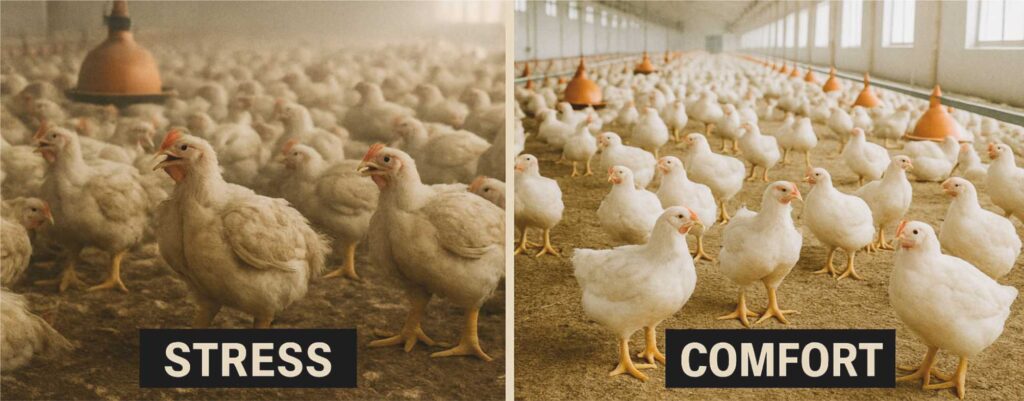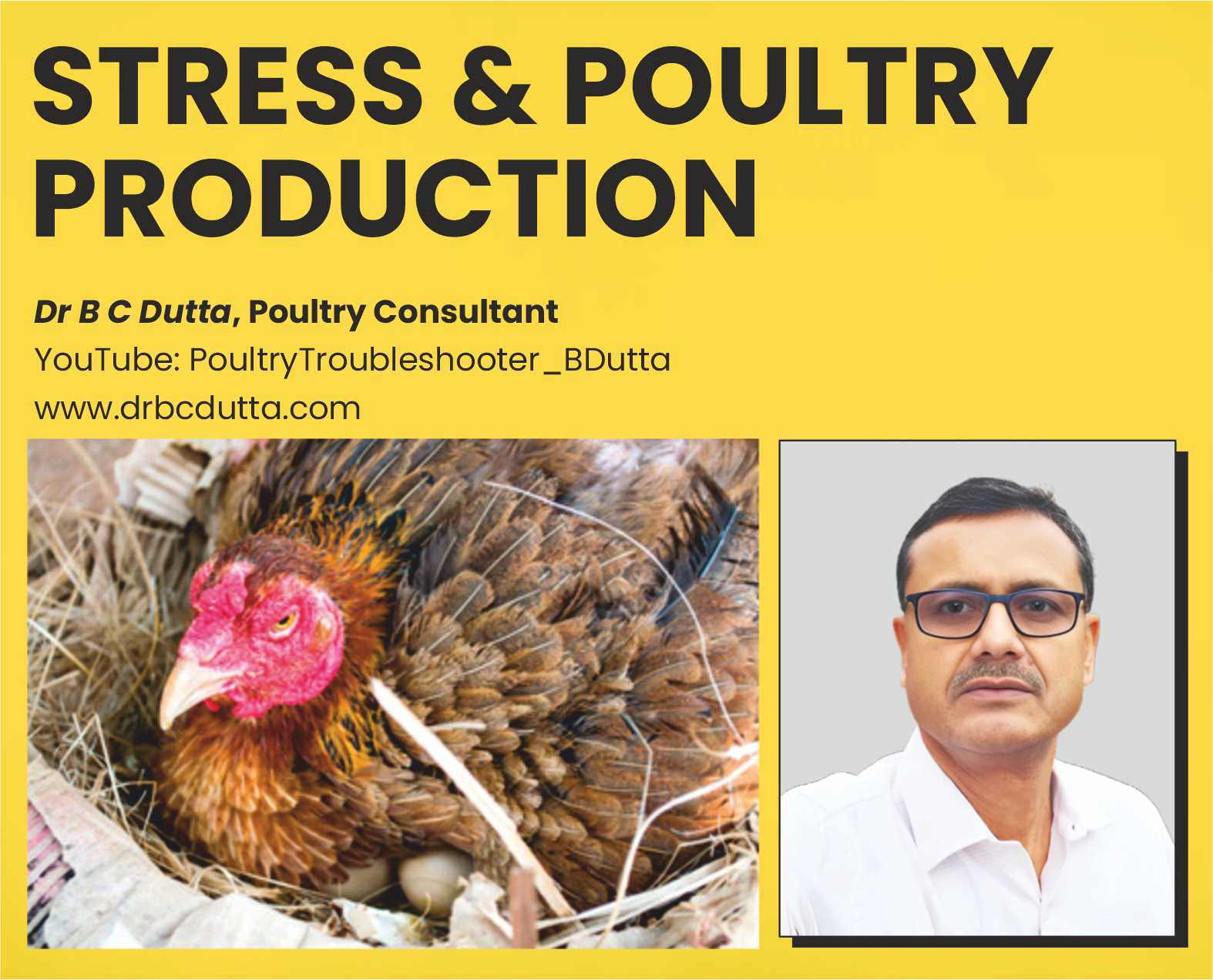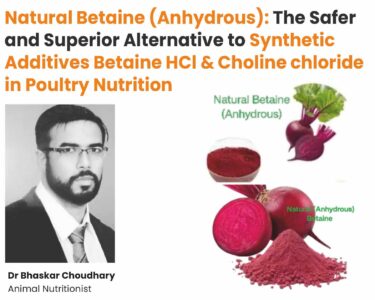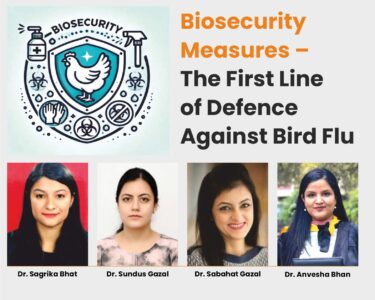What is Stress?
• Stress is a state of worry caused by a difficult situation, a natural response to address challenges & threats in life. Stress is a situation just opposite to Comfort
• Chicken has a limited amount of stored up resources to help adapt to unstable conditions, a challenge or a threat. As long as the challenges are within tolerable limits, chicken manages through its reserves, adjust to the situation & come out with little/no damage
• Stress is the situation when these challenges are more intense or greater numbers, resulting a serious chemical, physical & psychological changes in chicken with harmful consequence

Picture 1
Development stages of Stress in Chicken
– The 3 stages of Stress are ALARM, ADAPTATION & EXHAUSTION
– The first stage is Alarm, a short neurological stage. It is the ‘fright or flight’ reaction based on adrenalin release which triggers the release of glucose into the blood & helps the bird prepare to power to escape
– Adaption is next, where hormones are released to control the long-term effects of stress as they adjust to the new changes in their environment. There may be elevated cortisone levels in the blood, which arrange release of glucose from the body’s reserves of carbohydrates, proteins & fats to help the bird to adjust to the stressor. Diseases associated with long term stress, like diseases of heart, digestive system, metabolic imbalances and susceptibility to disease, are all attributed to high corticosteroid production in managing long term stress.
– The third stage, Exhaustion occurs when chicken does not recover from the stressor, its body reserves depleted, and the normal metabolic function fails with death of the bird.
Once chicken is exposed to stress, it results in immunological or metabolic consequences as below:
– Regression of immune organs/systems leads to Suppressed immune function & increased disease susceptibility
– Reduction of the oxidative metabolic capacity of mitochondria
– Deficit of antioxidant reserves
– Changes in the activity of antioxidant enzymes
Types of Stress in Chicken
– Noticeable Stress
– Disease
– Environment; Heat Stress, Winter Chilling, High Speed Wind (Cyclone), Poor Ventilation
– Starvation or Drinking Water shortage
– Debeaking
– Non-Noticeable Stress
• High performance; rapid growth and peak egg production
• Overcrowding
• Mycotoxin
• Endotoxin
• Wet Litter
• Litter Ammonia
• Poor Quality Feed
• Change of Feed
• Handling
• Transportation
• Vaccination
• Transfer/Mixing/Isolation
Factors responsible for Stress in Chicken:
A. Physiological
1. High Body Weight Gain in Broiler
2. Egg Laying, especially Peak period in Layer & Breeder
B. Nutritional
1. Feed Starvation due to poor supply or inefficient feeding system
2. Drinking Water scarcity
3. Deficiency of Protein, Carbohydrate, fats, Minerals, & Vitamins.
4. Poor quality like Dusty, too Hard or too Big Particle size or old damage feed
C. Environmental
1. Heat Stress
2. Winter Chilling
3. High Humidity
4. Cyclonic Wind
5. Lightening
6. Splash of Rain water
7. Earthquake
D. Operational
1. Debeaking or Beak Trimming
2. House/Cage Transfer, Mixing & Isolation
3. Transportation from one farm to another (Chick to Grower and to Laying farm)
4. Vaccination
5. Handling for Insemination, medication & vaccination
6. Management issues like poor Space (overcrowding), Ventilation, Wet litter, Litter Ammonia
7. Change in Feed
8. Change of attendant
E. Pathological
1. Infections; bacterial, viral, fungal, protozoan, etc
2. Metabolic Disorder like gout, ascites, etc.
3. Endotoxins
4. Mycotoxins
Out of all above, the important & dreaded stresses are all Pathological stress like Infections, Mycotoxins, Endotoxins, Metabolic disorders and 2 environmental stresss, viz. Heat Stress & Cold Stress or Chilling. Please remember when one stress comes after another, then 1 + 1 is not 2 but become 11, means combined stresses are dreaded to chicken.
Heat Stress:
– Heat Stress is a situation when chicken faces difficulty in achieving balance between body heat production & body heat loss
– Chickens lack sweat glands to facilitate latent heat loss by evaporation (perspiration), and have limited un-feathered body surface areas for loss of sensible heat through conduction, radiation, & convection
– Genetics, Feather cover, Age, Body Weight, Egg Production stage & flock maintenance all affect a chicken’s heat tolerance
– Chickens are homeotherms & regulate their body Temperature across a wide range of external Temperature.
– But continuous high climate Temp overwhelm the thermoregulatory mechanisms, resulting imbalance between the amount of metabolic heat produced & their capacity to dissipate body heat in the environment
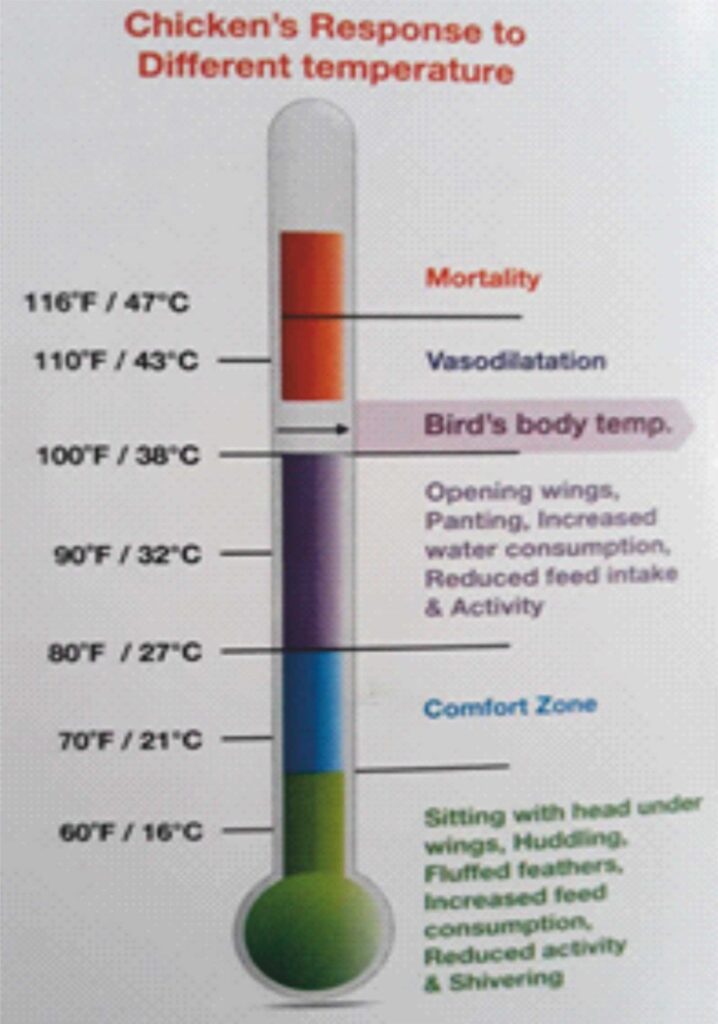
Picture 2
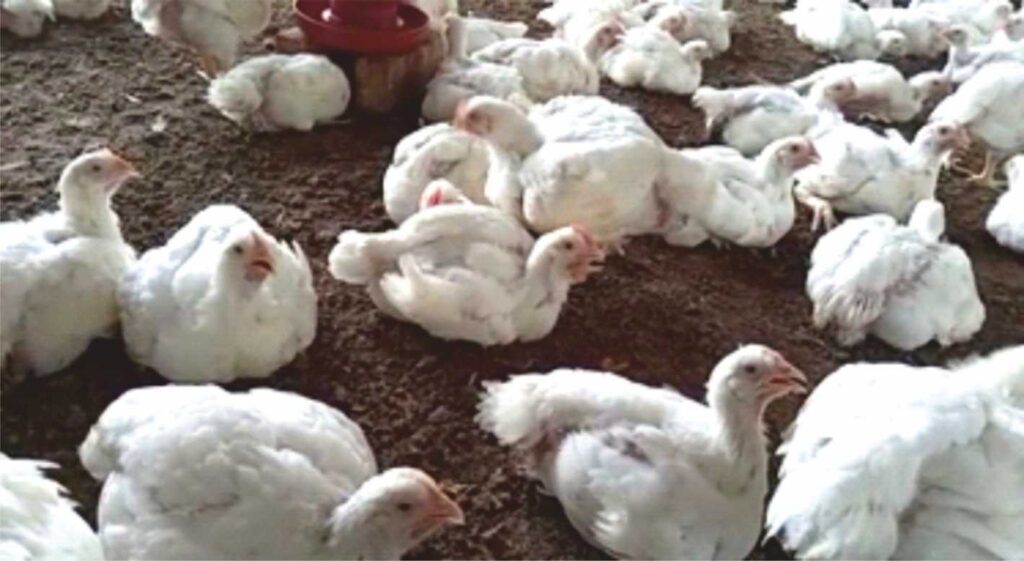
Picture 3
Physiological response of Chicken to elevated temperature and the Loss in Poultry?
– With Increase in Climate Temp, the Thermal gradient between the Body surface & the surrounding environment lessens with Dissipation of Heat decreasing, resulting Chicken suffering from environment-induced Hyperthermia.
– This increases Respiratory rate (Thermal Polypnea or Panting) to increase Latent Heat Loss via Evaporation of water from the Respiratory tract
– Dehydration is the most harmful effect of panting, which causes Respiratory Alkalosis, acid base imbalance leading to permanent physiological damages
– Alkalosis reduces blood ionized Calcium and ultimately Eggshell mineralization resulting Reduced Egg production, Pale Egg, Soft Shell Eggs, Thin Shell Egg, Increased Broken egg % in Layer & Breeder
– Panting causes Oxidative Stress leading to Immunosuppression, damage of Gut mucosa leading to poor digestion, Dysbacteriosis, Enteritis and increase incidence of secondary infections (Viral like LPAI & ND, Mycoplasma & Bacterial) because of immunosuppression & leaky gut situation.
– Heat Stress reduces feed consumption resulting Poor Body Weight gain in Broiler and reduced Egg production in layer & breeder.
– Heat Stress has Permanent damaging effect; damages the muscles affecting Meat Quality and Lowering Breast Muscle Yield
– Reduces Protein content of the muscles, reduction of muscle pH & Water Holding Capacity and ultimately affecting Juiciness of Chicken Meat
– Disturbs Lipid metabolism by affecting enzyme function in lipid breakdown causing Excess Fat deposition instead of converting to meat
– Heat Stress reduces Male fertility in breeder and affects hatchability severely.
– Heat Stress impact the Expression of Gene related to Growth, Production Performance & Resistance to disease
– Heat stress impairs chicken’s immune system, leading to a reduced response to vaccines, suppressing the production of antibodies and affecting the function of immune cells, particularly lymphocytes, due to the atrophy of immune organs like thymus under high temperatures; heat stress makes it harder for chicken to fight against infections after vaccination and increases their vulnerability to disease
– Heat stress lowers the level of circulating antibodies (IgM & IgG) produced after vaccination, resulting in a weaker immune response against pathogens
– High Temp cause atrophy of thymus, leading to decreased T-cell production and impaired cell-mediated immunity
– Heat stress increases release of corticosteroid and further suppress the immune system.
– Heat stress disrupts the function of immune cells; macrophages & lymphocytes, affecting their ability to recognize and fight pathogens.
– Heat stress damage the intestinal lining, allowing entry of harmful & resident microorganisms into the body system to produce infections.
How to reduce the effect of heat stress in Chicken?
– Poultry House Environment need to made near comfort zone in terms of Temperature, Humidity & Ventilation. Closed Environment Control poultry house is the perfect answer.
– Plantation of Tress on both side of each shed
– Farm construction near forest or under Coconut or Mango Garden
– Reduce Stocking Density in summer to provide more space & more ventilation
– In open house system action must be taken to REDUCE TEMPERATURE at Birds level through
I) Elevated Roof, higher centre height
ii) Coated Roofing materials
iii) Extended side roof overhang to prevent entry of direct Sunlight
iv) Thatching of Roof by Agricultural waste (Paddy & wheat straw, Jute stick, Mustard/seasame harvested dry plant) and Ceiling by Thermostat Aluminium foil
v) Constructing Side Pandals (Leaned Roof Over-hang 1 meter)
vi) Hanging of Gunny with Dipper on both side (2 layers is best)
vii) Ceiling fans in case of Broiler and Circulatory fans in Layer or breeder to improve ventilation
viii) Springler on Rooftop to cool the roof
ix) Fogger inside the shed to reduce inside temperature
Disease Stress:
– Dis ease (Not fine) or Disease is No 1 stress factor in chicken like all other living being. Even unnoticed infection cause stress to force chicken to sit without movement and stay away from feed & water.
– Stress due to Diseases is the most neglected chapter in poultry farming, especially the subclinical or asymptomatic diseases.
– Global Animal Productivity loss due to clinical & subclinical diseases is 20%. Hence, we need to understand the disease stress on chicken and must act to minimize the same.
– Every disease has some specific symptoms but there are some common manifestations to every disease as below:
1. Anorexia or off-feed
2. Dullness, lack of movement or inactive
3. Poor eye reflection
4. Huddling
5. Poor body Weight Growth and poor Egg production
6. Death
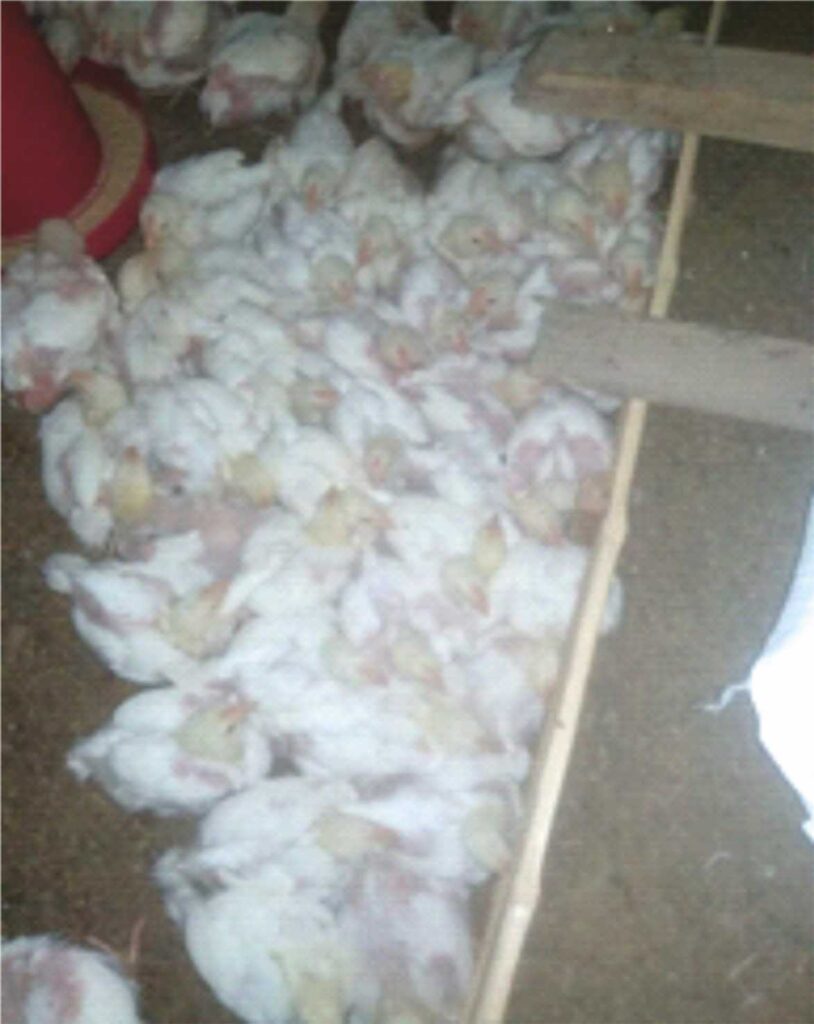
Picture 4
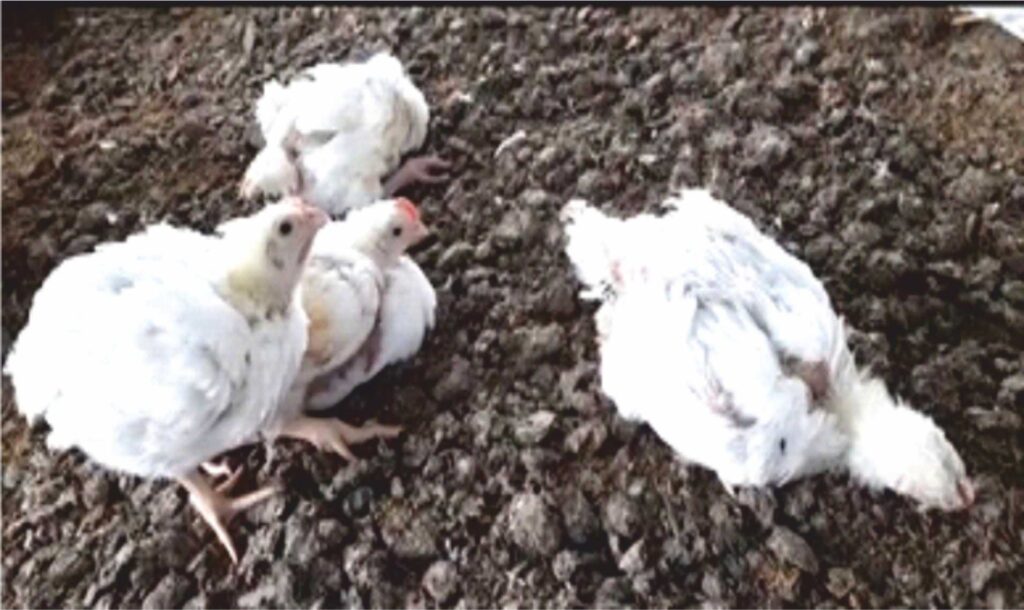
Picture 5
Disease Stress produces:
– Uneasy physical status beyond comfort level
– Many physiological changes in the body resulting different symptoms
– Loss of appetite, poor growth & poor production
– Direct or indirect Immunosuppression inviting many other diseases
– Death due to system failure or lack of food for long time anorexia
Mitigation of Disease:
– Practical & 100% Biosecurity to avoid disease entry in to the poultry area.
– Welfare of chicken with respect to space, ventilation, temperature, drinking water & nutrition
– Daily Health monitoring
– Monitoring of Bird’s activity & Feed Intake everyday
– Immediate identification of any deviation in health & production parameter
– Immediate diagnosis at farm & confirmatory from laboratory
– Immediate treatment or necessary action to protect the health & life of chicken
How to Recognize Stress in Chicken
– Vocalization: Chickens have alarm sounds to alert other chickens, like repetitive chirps or screaming.
– Loss of Appetite; poor feed consumption, eating little sometime & stay away from feed in almost all stresses including Heat or Cold stress and disease stress.
– Abnormal Posture: In Heat Stress Birds sits on its belly & breast touching the floor and wings spread apart to lose heat through conduction, convection & radiation. In case of Disease Stress, birds are usually inactive & huddle together near to corner or at areas of Sunlight in open shed.
– Abnormal Behavior: In Heat Stress, there will be too much Panting to lose body heat through evaporation. During disease stress, the birds remain inactive and lying with head down & beak inside litter. Deep breathing is seen in respiratory diseases.
– Water Intake: Heavy increase in case of Heat Stress but reduced in Cold stress and in most diseases.
– Repetitive Behavior: include packing, constant rocking back & forth, head swinging or toe-taping
Effect of Stress in Chicken
– Uneasy state of life, abnormal posture & abnormal activity
– Stressed chickens usually extremely anxious, pick feather & self-mutilate, may cause permanent damage of feather follicles and scar develop on their skin
– Reduced Feed intake & reduced water (except Heat Stress) intake
– Immuno-suppression leading to many diseases from already existing microorganism in the house environment or in the intestine as commensal
– Oxidative stress leading to damage of gut mucosa, poor digestion, dysbacteriosis and enteritis
– Panting & Dehydration
– Excess release of Stress hormone (corticosteroid) leading to further immunosuppression & loss of body condition
– Poor commercial performance like, poor body weight gain & high FCR in broiler and reduced egg production with poor egg shell quality in layer & breeder
– Mortality
Mitigation of Stress in Chicken
– Maintain clean, calm & disease-free poultry house environment
– Noise-free environment; chicken don’t like unusual circumstances
– Avoid environmental stress like winter chilling, summer heat stress, monsoon high humidity inside poultry house through modification of infrastructure & husbandry practice.
– Need conceptual, infrastructural & operational changes to avoid environmental stress with climate change induced global worming situation.
– Avoid compromised ventilation, especially during winter & rainy days in open system farming. Avoid poor ventilation during high humid monsoon & chilly winter months in EC shed especially with compromised structure
– Avoid overcrowding; welfare is most unattended issue creating stress in poultry
– Avoid litter ammonia, wet litter & dust in poultry house
– Follow SOP & behave gently while handling, transfer, mixing, transportation, vaccination and insemination.
– Implement 100% Biosecurity, arrange regular health monitoring & health management. Educate your team about importance of biosecurity in poultry.
– Making sure your flocks have access to safe drinking water and regular supply of recommended fresh nutritious feed during the whole production cycle.
